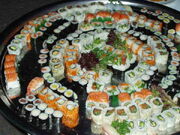===

Yummy Sushi
Japan is a home for many kinds of sushi, but in foreign countries, Sushi no longer exist, and even if it does, not at its original form. It is important to say that the origin of sushi is not Japan. Original “sushi” comes from 7th century China. People began making sushi to preserve fish by fermentation since there where no refrigerators. Since rice and salt where one of the key ingredients in fish fermentation, sushi became closely related to Japan. And there, it evolved into the current sushi, which combine fish and rice.===
Since Japan is surrounded with water, a wide variety of fish could be found. And topography of Japan is mountainous so it also makes a great environment for rice cultivation. Japanese people have always fed themselves from sea and rice fields.
Original method of sushi preparation included following steps:
Cleaned raw fish was pressed between layers of salt, and stone was placed to weight it. After few weeks usually three, stone would be removed and placed with a light cover. Few months later, fermented fish and rice where ready to be consumed.
There are few restaurants in Japan that are still serving originally-style sushi. That kind of sushi is called “nare” – sushi made with freshwater carp.
During the eighteenth century, a chef named Yohei decided to serve sushi in its present form. It became very popular in a short period of time and it evolved in two styles: First one was “Kanasai” style, named by Kansai - region in Japan. And the second one was named “Edo” style, from Tokyo, which was called Edo in that time.
Kansai style sushi consisted seasoned rice mixed with other ingredients, including very decorative packages, and it has more history and techniques to it comparing to the Edo style sushi.
Edo style sushi is nigiri sushi (it is also known as Edomae-sushi); this kind of sushi had small amounts of seafood on seasoned rice.
Kansai region's ornamental sushi is very popular, but foreigners are more interested in nigiri sushi.
Nare-sushi is a sushi made with carp in the vicinity of Lake Biwa in Shiga Prefecture, and believe it or not preparing this sushi takes from 2 months to more than one year.
When it was eaten, they only ate the fish, and discarded the rice. People eventually understood that this was a process that consumed too much time and wasted a lot of rice. These thoughts led to the development of nama-nare or han-nare sushi, which can be made in a few days, and it consisted of eating both fish and the rice.
1824 was the year when a man named Hanaya Yohei got the idea of eating sliced, raw seafood at its freshest. He served the raw fish on small fingers of vinegared rice, and the stall he opened became very popular. And sushi stalls were emerging almost everywhere in Edo by the middle of the 19thCentury.
The stalls had wheels so when the sushi makers found a popular spot to do their business; they almost did everything they can to get the spot. People stopped by for a snack in their stalls, and there were no formal table manners as there is today. They used fingers to dip sushi in the soy sauce etc., and wiped them off on the noren, which became well stained at the end of the business hour, and showed the sushi maker how well the business went that day.
Many years of training and preparation has led to the development of culinary experts known as Sushi Chefs. These individuals were traditionally trained within strict apprenticeship programs while under the watchful eye of a Master chef. Upon graduation, the Sushi chef may hold an honoured position and earn the respect and admiration of their peers.
Not only does a sushi chef make the food look appetizing, but also they are involved in every detail of the preparation. Even haggling with the fisherman for the freshest catch, preparing the many different types of Sushi, conversing with the customers and 'putting on a show'.
After the Great Kanto Earthquake of 1923, many elegant sushi shops were emerging. Even though they had chairs and tables, some of the customers consumed their food outside. So during this stage, the noren hung from a bar in front of the shop. And after the World War II, sushi stalls were no longer seen. During the 1960s, people realized that eating while standing wasn't a formal manner, so they began to eat seated as it is today.
Sushi is low in fat and nutritious. A typical setting of 7-9 pieces of sushi contains about 350-400 calories. The fish is a wonderful source of protein and also provides a good source for omega-3 fatty acids. Seaweed is rich in iodine and rice provides complex carbohydrates. A wonderful, well rounded eating alternative.
